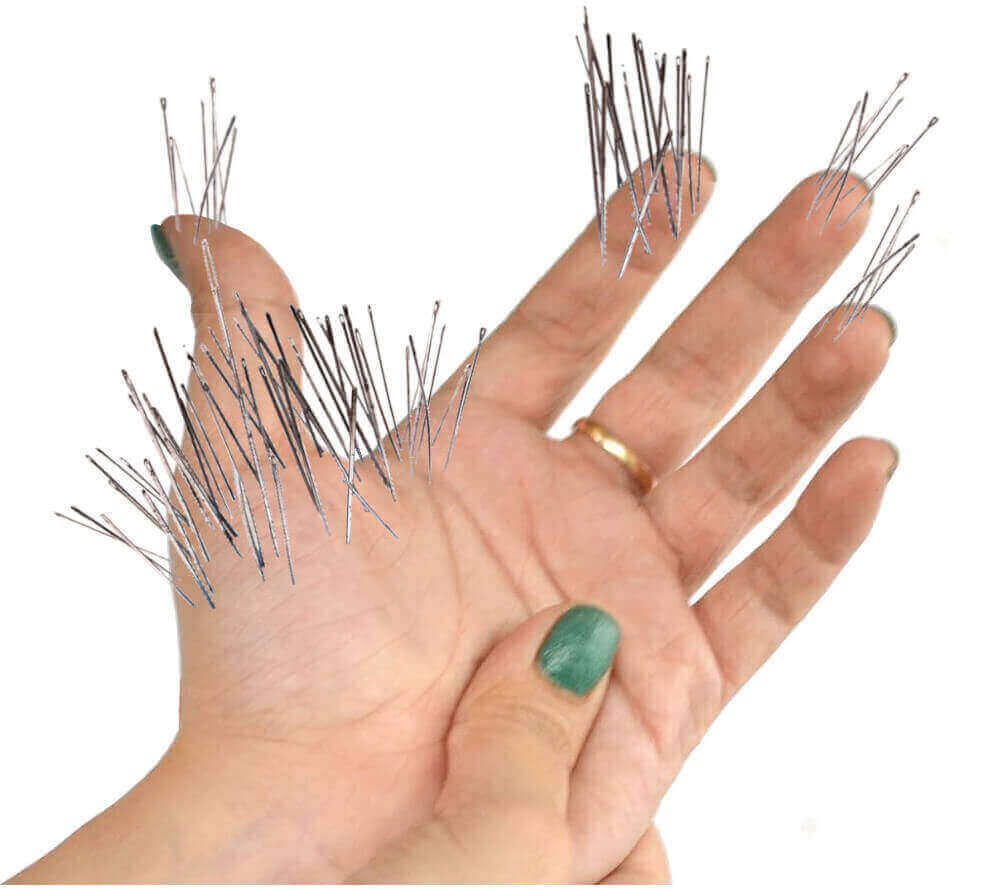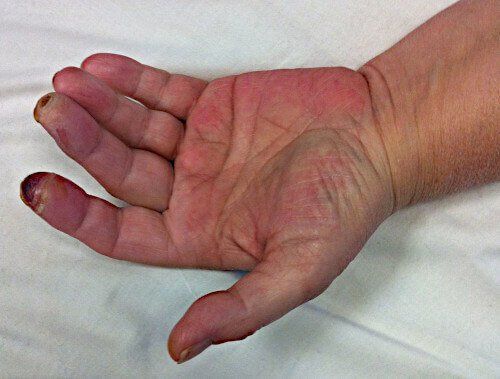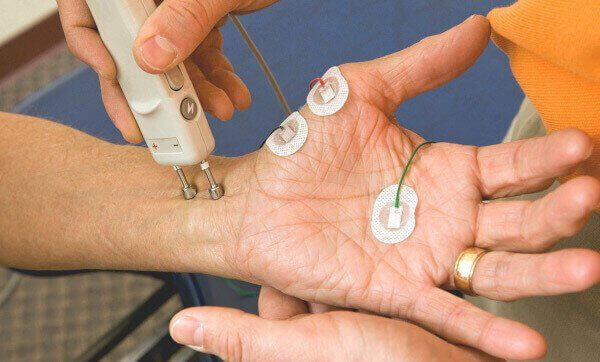Is Carpal Tunnel Painful or Numbing?
From Dr. Z - Carpal tunnel syndrome specialist
Is Carpal Tunnel Syndrome Painful?
Asking the question, "Is carpal tunnel painful?" is like asking, "Are plants green?" The answer is "sometimes".
Carpal tunnel syndrome can cause either pain or numbness or tingling - or all three of those symptoms at the same time. It's also common to have numbness or tingling without pain. Here's what's going on inside your hand and wrist.
- FIND OUT: do you have carpal tunnel?
No strings attached self-test.
How does carpal tunnel happen?
Carpal tunnel syndrome is the most common of the entrapment neuropathies. In other words, it means the median nerve is trapped or squeezed too tightly inside the wrist joint.
All of the symptoms of carpal tunnel syndrome are caused by this entrapment. So what causes the entrapment?
The entrapment results from swollen tendons (more about this below). And the tendons swell because they become irritated. That irritation is most commonly caused by straining and stressing your tendons.
You can strain tendons several ways. For example, moving your fingers rapidly and repetitively, like typing too much. Gripping objects or forming a pinching action for prolonged periods of time also strains tendons. This finger and hand over-activity is why certain occupations are known to be associated with getting carpal tunnel syndrome.
Why is carpal tunnel painful?
Did you ever lean on your funny bone (at your elbow)? As a result you get tingling or pain in your hand. In fact, the funny bone is the ulnar nerve inside the elbow. So if you press on the ulnar nerve at the elbow your hand and fingers feel tingly.
It’s about the same thing with carpal tunnel syndrome. Squeezing or compressing the median nerve at the wrist joint causes numbness in the hand and fingers. But that squeezing is not from leaning on the wrist. It comes from swelling & fluid buildup deep inside the wrist joint. (In fact, most carpal tunnel syndrome remedies completely ignore this crucial concept.)
The median nerve gets compressed as fluid builds up around the tendons right next to it. Exactly why the tendons swell is still debatable.
To visualize what happens, think of a blood pressure cuff on your arm. The cuff represents the tendons getting swollen due to fluid buildup. Your arm is the median nerve. Therefore, with more compression, the median nerve reacts by producing abnormal sensations. That’s why this condition causes pain, tingling and numbness in your hand and fingers.
So is carpal tunnel painful, numbing or tingly?
Actually, it's all three of these sensations.
All nerves react badly to squeezing pressure, just like your funny bone. And that includes the median nerve. Squeezing it produces the terrible abnormal sensations in order to warn you that it's in trouble. The idea is for you to take care of the trouble, like removing the pressure on it.
You can remove the pressure on your funny bone just by not leaning on it anymore. But it’s not so easy to relieve the pressure inside the wrist joint.
As the nerve is compressed more and more inside the wrist, the warning signs and symptoms of carpal tunnel syndrome intensify. These signs are almost always either:
- Pain
- Numbness
- Tingling (pins & needles)
When carpal tunnel syndrome first starts, symptoms generally begin in you fingertips. Sometimes a whole finger, like the thumb or forefinger is involved. Less frequently, the palm shows symptoms first.
Your fingers or hand can have one, two or all of these symptoms. The combination of two or three of these sensations is most common.
It’s rare for carpal tunnel symptoms to begin quickly. Instead, they start gradually over weeks or months. In fact, it's so gradual that it may even take a month to be conscious of a problem going on in your hand.
So is carpal tunnel painful? It can be. But it can also show up as numbness or tingling - or all of them at once.
How carpal tunnel progresses
Usually within 6 months carpal tunnel symptoms progress further. A person might feel sensations in the palm of the hand and/or the entire finger or multiple fingers.
Essentially, it spreads - and it generally spreads fast. That's why it's important to get treated early.
Whatever the initial sensation was, in more moderate stages carpal tunnel the symptoms almost always appear as a combination. In other words, it's not very common for just one symptom to be intense now.
By far, the most common carpal tunnel symptoms combination is numbness and pain. But they might include tingling, burning, itching, and soreness. The thumb, index and middle fingers are usually especially bad. Often, fingers feel swollen, but they’re not.
This is also when pain, numbness or tingling wake you up at night. Most people feel they have to "shake out" their hand for relief.
These sensations can also occur in one hand or both hands at the same time. This is called bilateral carpal tunnel syndrome. It happens in 80% of people.
Whatever your symptoms are, there's one thing to appreciate about carpal tunnel: painful, tingly or numb feelings will worsen with time. As symptoms progress to a more severe stage, you might also feel a loss of grip strength. For instance, it might be hard to make a fist or pinch small objects.
In severe and chronic cases that go untreated, there is also muscle wasting at the base of the thumb. You can see this as a flattened and wrinkled area that should normally be round and plump. (See photo below.) This means the nerve to your thumb muscle is dead, and the muscle itself is also dying.
One of the most detrimental results of moderate or severe carpal tunnel syndrome is that most patients lose sensations of hot and cold permanently. This can be dangerous because scalding or burns in the kitchen are common in these patients. The photo below illustrates such a patient.
Also, the fact is, carpal tunnel painful feelings can appear differently. For example, patients can feel pain that’s sharp, stinging, dull, grinding or burning. Sometimes "electrical" pain shoots from the fingers and up the arm. Sometimes pain radiates up the arm.
Whatever the sensation is, carpal tunnel symptoms NEVER involve the little finger.
How is carpal tunnel diagnosed?
Whenever a patient asks me, "Is carpal tunnel painful?" I always reply, "It can be...do you have another sensation in your hand?"
The answer is almost always, "Yes, I have numbness (or tingling)." That means a proper diagnosis should be made immediately so the condition can be treated and not progress further.
That progression is why early diagnosis and treatment of carpal tunnel syndrome is vital . Most importantly, early diagnosis will prevent damage to the median nerve. That means you can avoid permanent loss of hand function.
Physical Exam
To diagnose carpal tunnel syndrome, a doctor first performs a physical exam of the hands, arms, shoulders and neck. This exam is very important. The doctor can determine if the symptoms are carpal tunnel syndrome or something else.
Above all, the exam may identify which other condition is causing the symptoms. Several conditions can mimic carpal tunnel syndrome. Wrist tendonitis is among the most common and the most often misdiagnosed. That’s why a diagnosis of carpal tunnel syndrome is often wrong.
The doctor should conduct a thorough exam including:
- Close inspection of the wrist for tenderness, swelling, warmth, and discoloration.
- Testing each finger for sensation.
- Examination of the muscles at the base of the hand.
- Determination of hand & finger strength, and signs of wasting.
- Prescribe routine lab tests and X-rays to rule out diabetes, arthritis and fractures.
Provocative tests
Other tests
Sometimes doctors use EMG (electromyography) and nerve conduction (EDX) tests to confirm carpal tunnel syndrome. The doctor puts very thin electrode needles into the hand and wrist. Then the doctor applies weak electric shocks. This measures the nerve’s health.
These are expensive and painful procedures. Moreover, recent studies show EMG and EDX tests are not very accurate in diagnosing early carpal tunnel syndrome. They also have problems with too many false results.
After decades of use, the provocative tests are still far more accurate. As a result, the EMG and EDX tests are not used very much anymore, except perhaps to confirm the diagnosis of provocative tests.
Conclusion
Is carpal tunnel painful? Yes! But it can also give you numb or tingly feelings. These sensations in your hand and fingers can be one or all of these symptoms. So if you have any of them, get a diagnosis immediately so you can start treatment. That's because in most cases, symptoms will only worsen if they're not treated right away. The longer you wait before getting treatment, the harder it is to reverse symptoms and restore your hand to normal again.











